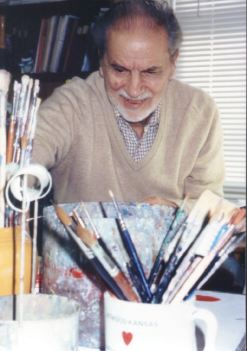the john muir exhibit - stamps - wendelin
Rudolph Wendelin
Designer of the 1964 John Muir Commemorative Postage Stamp

November 24, 2022: An updated, fully illustrated version of this article is now available in PDF format.
John Muir is one of very few Americans who have been honored by a commemorative postage stamp; and a member of an even more select lot for whom two commemorative stamps have been made. The first stamp was issued in 1964, and the second in 1998 as part of the "Celebrate the Century -1900's" series.
The design of the 1964 stamp was in the hands of a kindred spirit.
That stamp was the work of artist Rudolph Wendelin of Arlington, Virginia, famous as the primary guardian of Smokey Bear. Wendelin is a man who used his art to the same purpose that Muir put his prose and poetry - recognition of the wonders of Nature and the need to preserve these for future generations.
Where Muir, at the turn of the century, crusaded to save California's giant redwoods, Wendelin, at mid-century, spent much of his career fighting forest fires. His helper was Smokey Bear, a friendly cartoon character who has showed up constantly on TV, billboards, posters, and in newspapers and magazines in the last forty years. Wendelin did not create Smokey -- at least ten other artists earlier turned out different versions of the bear - but he was responsible for giving Smokey the friendly and personable qualities he is so well known for today.
Rudolph Wendelin was born February 27, 1910 in Herndon, Kansas. He grew up in Ludell, Kansas, then attended the University of Kansas School of Architecture, and art schools in Milwaukee, Wisconsin, and Washington, D.C.
He began his career with the U.S. Forest Service in 1933 as a draftsman and illustrator in Milwaukee. In 1937, he was transferred to Washington D.C. where he worked on exhibits and visual illustrations as an illustrator.After wartime duty in the Navy, he rejoined the Forest Service in Washington, D.C., where he helped to launch the Smokey Bear project. He has painted Smokey in hundreds of situations that point to conservation of natural resources and prevention of forest fires. Smokey is a public service project of the Advertising Council, Inc., to aid State and federal Forest Services.
Mr. Wendelin retired from the Forest Service in 1973.
When invited to submit designs for the 1964 John Muir commemorative stamp, Wendelin prepared himself by reading heavily of the naturalist's work to catch the mood. He became so engrossed with Muir that he did a portrait and bust in walnut of the famous naturalist. Later, he also painted the portrait of Muir that was used when Muir was inducted into the National Wildlife Federation's Conservation Hall of Fame in 1965.
The Postal Department limited the John Muir stamp to two colors, and at first Wendelin was dis-satisfied that there was not a yellow shaft of light in the forest scene. But later, after visiting Muir Woods and seeing for himself the bright green of the sunlight foliage and the deep green of the shaded areas he was glad two shades of green had been used for the stamp.
The 1964 Muir stamp was the first to depict the subject in two ways - a large portrait bust combined with a diminutive standing figure as part of the forest scene.
Wendelin also designed a distinctive personal First Day Cover which was one of the most attractive designs for the 1964 issue of the Muir stamp.
He designed other commemorative postage stamps as well as the Muir design.
These include the Forest Conservation postage stamp in 1958; an adaptation of Charles M. Russell's "The Trail Boss" as the design for the Range Conservation stamp in 1961; the 1969 John Wesley Powell stamp; and, finally, the 1984 Smokey Bear issue.
Wendelin also collaborated with Maurice Eysenburg in the design of the Fifth World Forestry Congress stamp in 1960.
Wendelin was also a creative painter of landscapes. For example, in the fall of 1963, Wendelin took a one-week pack trip through southern Colorado, and from his sketchbook emerged 24 watercolors which were displayed in Denver. He exhibited at the U.S. Department of Agriculture and the American Forestry Association, both in Washington D.C. He created a 28-foot mural of Rawlins County in Atwood Kansas, and has also exhibited at the Pinchot Institute at Grey Towers, Milford, Pennsylvania, as well as shows in Milwaukee, Wisconsin, and Topeka, Kansas.
Wendelin has received many awards for his work. Most recently, in 1998, he was presented with the Medal of Honor by the Daughters of the American Revolution for his work in popularizing Smokey Bear through his artwork. In addition to awards from the U.S. Department of Agriculture, he also received the Horace Hart Award from the graphic arts industry and both Silver and Gold Smokey Bear Awards from The U.S. Department of Agriculture. (Ironically, Wendelin had designed the latter's award Smoky statuette years before!)
Rudolph Wendelin, 90, died on August 31, 2000. Mr. Wendelin is survived by his wife Carrol;two sons, Michael and David; and a daughter Elizabeth.
Sources:
U.S. Post Office Department press release, January 12, 1964; First Day Cover brochure, April 29, 1964; The Man Behind the Stamp by Joseph T. Conway; "Smokey Bear Turns 50... and Rudy Wendelin helped get him there", by Sally Eauclaire, Southwest Art Magazine August,1994;
Smoky Bear article in People magazine in 1994; "Rudolph A. Wendelin: A Portrait", Journal of Forestry (Vol. 77., No. 12; Dec., 1979);
U.S. Forest Service Press Release, May, 1998;
DAR Congress Herald Volume 3, Issue 4 Wednesday, April 22, 1998;
Telephone Interview with Elizabeth Wendelin (daughter), January 16, 1999;
"Rudolph Wendelin Dies at Age 90" by Richard Pearson, Washington Post, September 3, 2000, INVENTORY OF THE RUDOLPH WENDELIN PAPERS, 1930 – 2005, (accessed 24 November 2021) from the Forest History Society.
Home
| Alphabetical Index
| What's New & About this Site